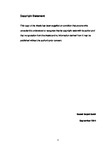Investigation of microplastic debris in marine surface waters using different sampling methods
| dc.contributor.supervisor | Thompson, Richard | |
| dc.contributor.author | Sadri, Saeed Seyed | |
| dc.contributor.other | Faculty of Science and Engineering | en_US |
| dc.date.accessioned | 2015-06-12T08:17:52Z | |
| dc.date.available | 2015-06-12T08:17:52Z | |
| dc.date.issued | 2015 | |
| dc.identifier | 10192785 | en_US |
| dc.identifier.uri | http://hdl.handle.net/10026.1/3363 | |
| dc.description | Chapter 5 of the thesis has been published in the Marine Pollution Bulletin | en_US |
| dc.description.abstract |
‘Microplastics’ are pieces of plastic debris <5mm in diameter. They are introduced into the marine environment directly for example via release of small pieces of plastics used as abrasives and indirectly through the fragmentation of larger items. The European Marine Strategy Framework Directive 2008/56/EC (MSFD) regards microplastics as an emerging issue of concern and calls for more data on the quantity, distribution and composition of this debris. This thesis examines the amount, composition and distribution of buoyant microplastic debris in marine waters using different sampling devices and methodologies. To investigate the spatial distribution, abundance and composition of microplastic debris between nearshore and offshore marine subsurface waters a subset of samples from the Continuous Plankton Recorder (CPR) survey were examined. Abundance was generally higher in nearshore coastal waters than the offshore oceanic samples, with the highest mean concentrations observed in the UK’s coastal waters of the northeast Atlantic and the southern North Sea. To validate the accuracy of the presence/absence of microplastic debris reported in the Continuous Plankton Recorder (CPR) samples by analysts at the Sir Alister Hardy Foundation for Ocean Science (SAHFOS) a subset of data was formally analysed using Fourier Transform Infrared (FTIR) spectroscopy. This analysis indicated a good level of accuracy (~66%) in the ability of the SAHFOS’ analysts to detect visually microplastic fragments during their normal processing of plankton samples. To compare quantity and composition of buoyant microplastic debris collected by two different approaches (CPR vs. Manta net) samples were collected from a similar body of coastal waters. The results showed significantly higher abundance of microplastic in samples collected by the manta net per unit of distance but no significant difference once the results were standardised per cubic volume of water. To assess the susceptibility of each method to ‘procedural contamination’, repetitive controlled tests were conducted to quantify the amount and composition of contaminants before, during and after the sampling programme. In both methods the highest number of contaminants was found on the net and prior to the deployment to sea. The semi synthetic Rayon fibres were the most abundant type of contaminants in both cases. To compare the abundance and composition of buoyant plastic debris in estuarine waters according to daily and lunar tidal cycles a mensurative experiment was conducted in a macrotidal Estuary. Microplastics comprised 82% of the debris and there was a significant difference in size frequency distribution between the spring and neap tides with more fragments of larger size observed during spring tides. In conclusion, this study shows further evidence of the spatial heterogeneity of microplastic debris distribution in marine waters and therefore also highlights the need for more comparable data from different marine habitats using standardised methodologies. | en_US |
| dc.description.sponsorship | Defra and Sir Alister Hardy Foundation for Ocean Science | en_US |
| dc.language.iso | en | en_US |
| dc.publisher | Plymouth University | en_US |
| dc.subject | microplastic debris in marine waters | en_US |
| dc.title | Investigation of microplastic debris in marine surface waters using different sampling methods | en_US |
| dc.type | Thesis | |
| plymouth.version | Full version | en_US |
| dc.identifier.doi | http://dx.doi.org/10.24382/4136 |
Files in this item
This item appears in the following Collection(s)
-
01 Research Theses Main Collection
Research Theses Main


